EYE EXAMS --Routine Eye and Vision Care for Children, Adults and Seniors

Routine eye and vision examination can identify asymptomatic eye and vision conditions. Early detection and timely management of these conditions are essential to protect your vision and keep your eyes healthy. Comprehensive eye examination can reveal not only common refractive disorders from nearsightedness, farsightedness, astigmatism, presbyopia, but also a wide variety of eye diseases such as Amblyopia (lazy eye), cataracts, glaucoma, retinal and optic nerve diseases, diabetes, hypertension, and even life-threatening ocular and brain tumors. So routine comprehensive eye exam can save your eye and vision, and sometimes can save your life as well.
We provide Comprehensive Eye Exams for All Ages. We offer routine eye and vision care services and prescribe glasses and contact lenses for children, adults and seniors. On your first exam in our office, we will perform refraction and a thorough dilated eye examination. We recommend that you plan on an appointment time of about one hour.
This is a Digital Fundus Photo of inside the eye. It shows you the retina (a light-detecting neural tissue lying in the back of eye), the optic nerve (eye’s sensory nerve that sends visual information from the retina to the brain for processing, labeled as ON in this photo), the macula (the central area of the retina that gives fine detailed central vision, labeled as MAC in this photo ) and blood vessels inside the eyes ( retinal veins and arteries) that could become abnormal and can be visually detected during eye exam in some systemic conditions such as Diabetes and Hypertension, etc.
We provide Comprehensive Eye Exams for All Ages. We offer routine eye and vision care services and prescribe glasses and contact lenses for children, adults and seniors. On your first exam in our office, we will perform refraction and a thorough dilated eye examination. We recommend that you plan on an appointment time of about one hour.
This is a Digital Fundus Photo of inside the eye. It shows you the retina (a light-detecting neural tissue lying in the back of eye), the optic nerve (eye’s sensory nerve that sends visual information from the retina to the brain for processing, labeled as ON in this photo), the macula (the central area of the retina that gives fine detailed central vision, labeled as MAC in this photo ) and blood vessels inside the eyes ( retinal veins and arteries) that could become abnormal and can be visually detected during eye exam in some systemic conditions such as Diabetes and Hypertension, etc.